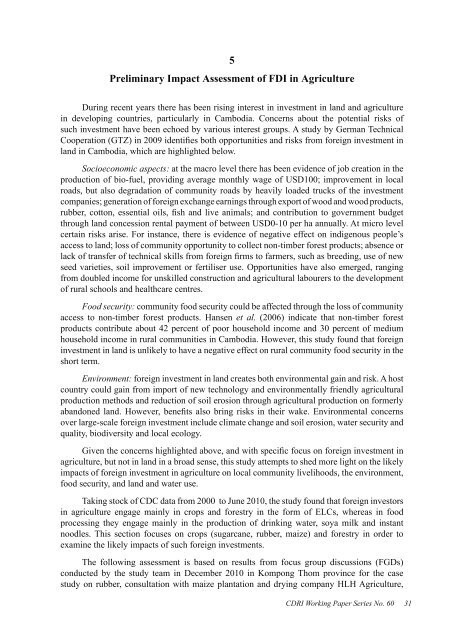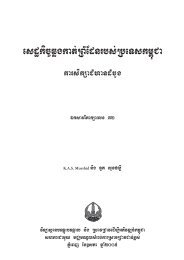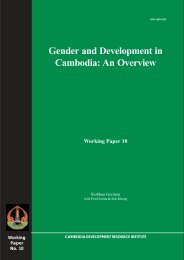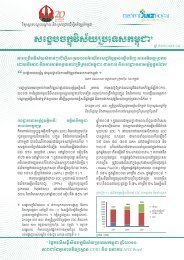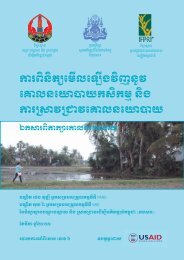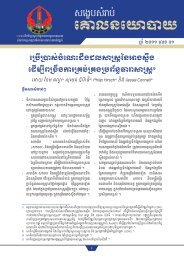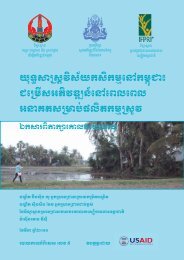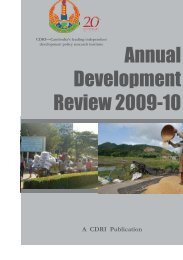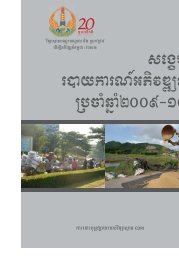Foreign Investment in Agriculture in Cambodia CDRI Working Paper ...
Foreign Investment in Agriculture in Cambodia CDRI Working Paper ...
Foreign Investment in Agriculture in Cambodia CDRI Working Paper ...
Create successful ePaper yourself
Turn your PDF publications into a flip-book with our unique Google optimized e-Paper software.
5<br />
Prelim<strong>in</strong>ary Impact Assessment of FDI <strong>in</strong> <strong>Agriculture</strong><br />
Dur<strong>in</strong>g recent years there has been ris<strong>in</strong>g <strong>in</strong>terest <strong>in</strong> <strong>in</strong>vestment <strong>in</strong> land and agriculture<br />
<strong>in</strong> develop<strong>in</strong>g countries, particularly <strong>in</strong> <strong>Cambodia</strong>. Concerns about the potential risks of<br />
such <strong>in</strong>vestment have been echoed by various <strong>in</strong>terest groups. A study by German Technical<br />
Cooperation (GTZ) <strong>in</strong> 2009 identifies both opportunities and risks from foreign <strong>in</strong>vestment <strong>in</strong><br />
land <strong>in</strong> <strong>Cambodia</strong>, which are highlighted below.<br />
Socioeconomic aspects: at the macro level there has been evidence of job creation <strong>in</strong> the<br />
production of bio-fuel, provid<strong>in</strong>g average monthly wage of USD100; improvement <strong>in</strong> local<br />
roads, but also degradation of community roads by heavily loaded trucks of the <strong>in</strong>vestment<br />
companies; generation of foreign exchange earn<strong>in</strong>gs through export of wood and wood products,<br />
rubber, cotton, essential oils, fish and live animals; and contribution to government budget<br />
through land concession rental payment of between USD0-10 per ha annually. At micro level<br />
certa<strong>in</strong> risks arise. For <strong>in</strong>stance, there is evidence of negative effect on <strong>in</strong>digenous people’s<br />
access to land; loss of community opportunity to collect non-timber forest products; absence or<br />
lack of transfer of technical skills from foreign firms to farmers, such as breed<strong>in</strong>g, use of new<br />
seed varieties, soil improvement or fertiliser use. Opportunities have also emerged, rang<strong>in</strong>g<br />
from doubled <strong>in</strong>come for unskilled construction and agricultural labourers to the development<br />
of rural schools and healthcare centres.<br />
Food security: community food security could be affected through the loss of community<br />
access to non-timber forest products. Hansen et al. (2006) <strong>in</strong>dicate that non-timber forest<br />
products contribute about 42 percent of poor household <strong>in</strong>come and 30 percent of medium<br />
household <strong>in</strong>come <strong>in</strong> rural communities <strong>in</strong> <strong>Cambodia</strong>. However, this study found that foreign<br />
<strong>in</strong>vestment <strong>in</strong> land is unlikely to have a negative effect on rural community food security <strong>in</strong> the<br />
short term.<br />
Environment: foreign <strong>in</strong>vestment <strong>in</strong> land creates both environmental ga<strong>in</strong> and risk. A host<br />
country could ga<strong>in</strong> from import of new technology and environmentally friendly agricultural<br />
production methods and reduction of soil erosion through agricultural production on formerly<br />
abandoned land. However, benefits also br<strong>in</strong>g risks <strong>in</strong> their wake. Environmental concerns<br />
over large-scale foreign <strong>in</strong>vestment <strong>in</strong>clude climate change and soil erosion, water security and<br />
quality, biodiversity and local ecology.<br />
Given the concerns highlighted above, and with specific focus on foreign <strong>in</strong>vestment <strong>in</strong><br />
agriculture, but not <strong>in</strong> land <strong>in</strong> a broad sense, this study attempts to shed more light on the likely<br />
impacts of foreign <strong>in</strong>vestment <strong>in</strong> agriculture on local community livelihoods, the environment,<br />
food security, and land and water use.<br />
Tak<strong>in</strong>g stock of CDC data from 2000 to June 2010, the study found that foreign <strong>in</strong>vestors<br />
<strong>in</strong> agriculture engage ma<strong>in</strong>ly <strong>in</strong> crops and forestry <strong>in</strong> the form of ELCs, whereas <strong>in</strong> food<br />
process<strong>in</strong>g they engage ma<strong>in</strong>ly <strong>in</strong> the production of dr<strong>in</strong>k<strong>in</strong>g water, soya milk and <strong>in</strong>stant<br />
noodles. This section focuses on crops (sugarcane, rubber, maize) and forestry <strong>in</strong> order to<br />
exam<strong>in</strong>e the likely impacts of such foreign <strong>in</strong>vestments.<br />
The follow<strong>in</strong>g assessment is based on results from focus group discussions (FGDs)<br />
conducted by the study team <strong>in</strong> December 2010 <strong>in</strong> Kompong Thom prov<strong>in</strong>ce for the case<br />
study on rubber, consultation with maize plantation and dry<strong>in</strong>g company HLH <strong>Agriculture</strong>,<br />
<strong>CDRI</strong> Work<strong>in</strong>g <strong>Paper</strong> Series No. 60<br />
31


